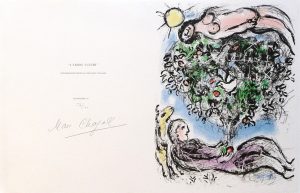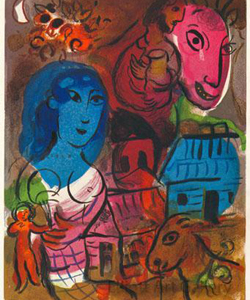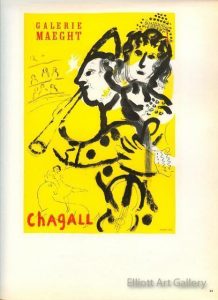Meet Artist Marc Chagall
At Elliott Art Gallery, we are proud to have works by Russian-French-Jewish artist Marc Chagall.
Marc Chagall’s legacy encompasses two pivotal dimensions, as art historian Michael J. Lewis aptly observed. Marc Chagall was most known for pioneering early modernism. Furthermore, people celebrate him as a significant figure in Jewish art.
Throughout his lifetime, Marc Chagall showcased his artistic versatility across various mediums. These mediums included paintings, book illustrations, stained glass, stage sets, ceramics, tapestries, and fine art prints.
Below we’ll take you through his history, as well as some of his most famous pieces and quotes.

History of Marc Chagall
Beginning of His Life
Marc Chagall was born Moishe Shagal on July 6, 1887, in a town near Vitebsk, Belarus. He was born to Hasidic Jewish parents and was the oldest of nine children. His early connection to Judaism is one that he would carry with him throughout his life and his art.
His parents worked hard to support their children. His mother ran a shop, while his father was a fishmonger. As a child, Marc learned about art and became inspired by the village he grew up in. His life as a child would stay with him and become a central figure in his artwork.
Art School
Leaving Vitebsk for St. Petersburg in 1906, he pursued an education in art. He studied the works of artists like Matisse, Fauves, Rembrandt, Caravaggio, Vermeer, Van Gogh, and Gauguin. Not only did he gain inspiration at art school, but he also discovered the world of theater and costume design. He also met his wife, Bella Rosenfeld, who would later become his muse.
Journey in Art
After art school, Marc moved to Paris in 1910. This was a significant time in Marc’s life, as it was then he changed his name to Marc Chagall. To him, Marc Chagall sounded more French.
During this time, Cubism was also taking off in the City of Lights. Living in an artist colony, Marc mingled with some of the best including Modigliani, Picasso, and Delaunay. Between his inner circle of artists and the Cubism movement overall, this time would have a serious impact on his work.
Marc Chagall thrived in the “golden age” of Paris, synthesizing Cubism, Symbolism, and Fauvism. Throughout his various artistic phases, his work retained an unmistakable Jewish essence. It is this essence that reflected his profound connection to his native village of Vitebsk.
World War I
Shortly before the war, Chagall found himself back in Vitebsk. However, as war broke out, he became stuck in Soviet Belarus. He became one of the country’s leading artists and a key figure in the modernist avant-garde. During this time, he even founded the Vitebsk Popular Arts School.
The War affected his art. He expressed his feelings for the war, deep longing for a more innocent time, and admiration for his wife through his work. During this time, heightened fervor and persecution of the Jewish people took place. This inspired him to evoke more of his deep-rooted faith in his work.
Surrealism
After World War I, Marc Chagall and his wife returned to Paris. Surrealism was then taking off in the city, which made Marc an even more popular artist of the time. Surrealists revered him, despite his active participation in the movement.
World War II
Marc’s respite would soon end at the start of World War II. The Nazis burned works of his and other artists of the time. They tried to eliminate any art that German museums deemed unfit. Even more, Marc Chagall’s life was also at risk.
Luckily, Marc and his wife, Bella, moved to America just in time. In 1941, they landed in New York. He kept a group of artists in the US and tried out designing sets and costumes during that period. However, tragedy followed him with the destruction of his hometown, word of concentration camps, and the loss of his wife.
Pushing Onward
After the war was over, Marc Chagall moved back to France. Despite his heartbreak, he never stopped creating art.
During this time, he expanded his repertoire to stained glass. Marc Chagall made beautiful windows for cathedrals, the United Nations, and the Jerusalem Windows in Israel. His creative repertoire also included large-scale paintings, notably his remarkable contribution to the ceiling of the Paris Opéra.
Death
Marc Chagall lived a long life, dying on March 28, 1985.
Reception
Renowned art critic Robert Hughes lauded Chagall as “the quintessential Jewish artist of the twentieth century.” However, Chagall himself saw his work as a universal dream transcending cultural boundaries rather than confined to specific people.
Art historian Michael J. Lewis recognized Chagall as “the last survivor of the first generation of European modernists,” emphasizing his enduring influence. For decades, he occupied the esteemed position of the world’s foremost Jewish artist.
In the words of Pablo Picasso, who spoke of Chagall in the 1950s, “When Matisse dies,” referring to another luminary of the art world, “Chagall will be the only painter left who understands what color really is.” Pablo is also known to have said, “I don’t know where he gets those images from; he must have an angel in his head.”

Paintings by Marc Chagall
Once you understand the history of Marc Chagall, his works take on a greater meaning. The artist used his love for his hometown, religion, and heartbreak during World War I-II in his work.
Below you will find some of his best works with an overview of their inspiration, meaning, and reception.
I and the Village, 1911
Marc Chagall created this work at a pivotal moment in his life. He had just moved from St. Petersburg to Paris after art school, enveloping himself into the excitement of Paris at this time. As mentioned previously, Cubism was at its height in popularity in Paris at this time. Marc Chagall clearly gained inspiration from this movement for I and the Village.
Marc Chagall’s longings for a more innocent time in his hometown of Vitebsk also inspired this painting. The painting is a surreal depiction of life in Russia with a village, a milkmaid, a farmer, and the head of a lamb. In the village, you can even see a church, which is a symbol of Marc Chagall’s deep commitment to his own faith.
Homage to Apollinaire, 1911-1912
During Marc Chagall’s time in Paris, he got to know French poet Guillaume Apollinaire. Apollinaire did paint, but he did become a central figure in the popular movements of the time.
This painting features two figures, a man and a woman, joined together. You can also see numbers and names on the painting, which were all special importance to Chagall. The painting also features a mix of vibrant colors, including red, orange, and green, among others.
Self Portrait with Seven Fingers, 1912-1913
Another painting created at a pivotal time of Marc’s life, Self Portrait with Seven Fingers includes notes of his time in Paris. It is another display of the dueling feelings residing deep in Marc at the time. Behind the man in the painting, you can see a window view of the Eiffel Tower. The painting in front of the man evokes a gentler depiction of Russian farm life.
The seven fingers also carry a special meaning. In Yiddish, “Mit alle zibn fingers” or “with all seven fingers,” means to work as hard as one can.
Paris Through the Window, 1913
Marc Chagall had a profound love for Paris. He depicted this love in his painting of Paris Through the Window, which incorporated elements of Cubism. In this painting, you can see the skyline of Paris, as well as the Eiffel Tower. The windowsill itself features a colorful windowpane, a cat, and a chair with a vase of flowers.
A theory, as explained by My Modern Met, suggests that the double-faced man in the painting represents a deeper truth. Chagall may have been attempting to express his admiration for Paris and his nostalgia for life in Russia. T The couple suspended in midair below the Eiffel Tower also symbolizes this theme.
The Birthday, 1915
Marc Chagall’s paintings often drew inspiration from his wife, Bella. Marc deeply loved his wife, and The Birthday portrays these feelings.
This painting was created right before their wedding. They say that Marc is the man floating above the woman in the painting, while Bella is the woman floating with the flowers. They’re floating in a dream-like state in a home setting to symbolize their everyday euphoria.
White Crucifixion, 1938
The time in which Marc Chagall painted White Crucifixion was a time of tension. Throughout the 1930s, people persecuted the Jewish people.
Marc Chagall felt deep pain during this time, depicting the suffering of him and his people in this painting. Christ is central in this painting as a martyr while people are fleeing all around him. According to My Modern Met, Chagall meant to compare the Nazis to the Romans who crucified Jesus.
Marc Chagall Quotes

Below are some of our favorite quotes said by artist Marc Chagall.
“If I create from the heart, nearly everything works; if from the head, almost nothing.”
“In our life there is a single color, as on an artist palette which provides the meaning of life and art. It is the color of love.”
“Love and fantasy, go hand in hand.”
“Color is all. When color is right, form is right. Color is everything, color is vibration like music; everything is vibration.”
“I had only to open my bedroom window, and blue air, love, and flowers entered with her.”
“In the arts, as in life, everything is possible provided it is based on love.”
“All colors are the friends of their neighbors and the lovers of their opposites.”
“What a genius, that Picasso. It is a pity he doesn’t paint.”
“Art seems to me to be a state of soul more than anything else.”
“I have always painted pictures where human love floods my colors.”
“You could wonder for hours what flowers mean, but for me, they’re life itself, in all its happy brilliance. We couldn’t do without flowers. Flowers help you forget life’s tragedies.”
“Only love interests me, and I am only in contact with things I love.”
Source: Goodreads
“I work in whatever medium likes me at the moment.”
“The dignity of the artist lies in his duty of keeping awake the sense of wonder in the world. In this long vigil he often has to vary his methods of stimulation; but in this long vigil he is also himself striving against a continual tendency to sleep.”
“When I am finishing a picture, I hold some God-made object up to it – a rock, a flower, the branch of a tree or my hand – as a final test. If the painting stands up beside a thing man cannot make, the painting is authentic. If there’s a clash between the two, it’s bad art.”
“Great art picks up where nature ends.”
Source: BrainyQuote
“If all life moves inevitably towards its end, then we must, during our own, color it with our colors of love and hope.”
“Art must be an expression of love or it is nothing.”
“All our interior world is reality, and that, perhaps, more so than our apparent world.”
“Mozart never composed anything, ever! He copied what was written on his soul.”
“If I weren’t a Jew then I wouldn’t be an artist, or at least not the one I am now.”
Source: QuoteFancy
Marc Chagall at Elliott Gallery
At Elliott Gallery, we are home to a collection of works by Marc Chagall. View our collection online or at our gallery in the French Quarter in New Orleans.
Our inventory includes the following.
Want to be the first to know which artist is featured in our weekly sale? Sign up below!
Discounts range from 10-30% and include FREE SHIPPING!

